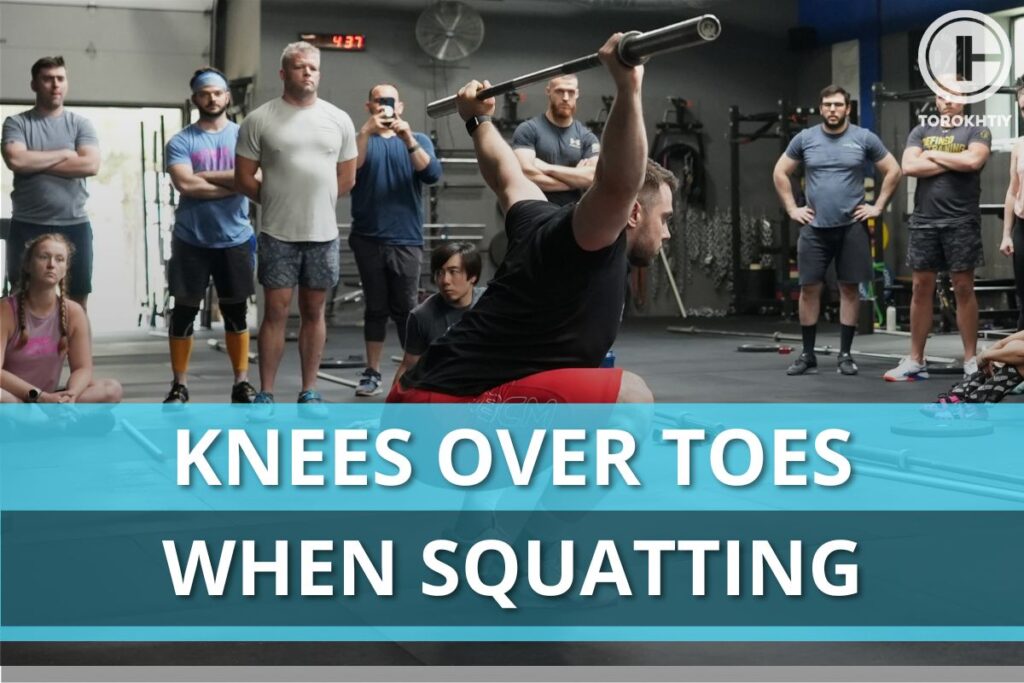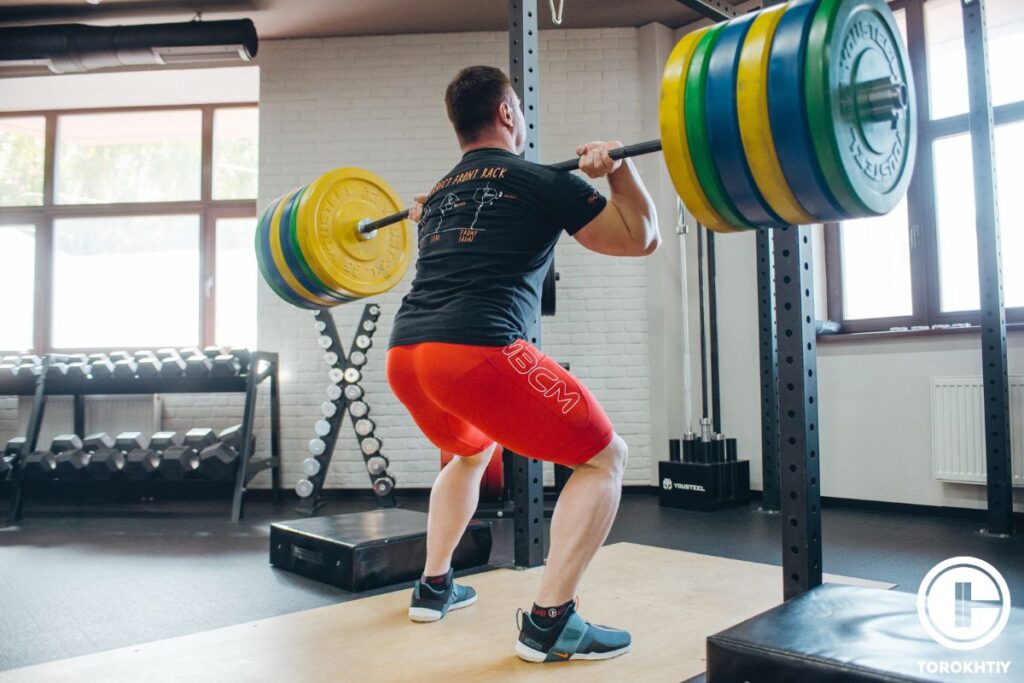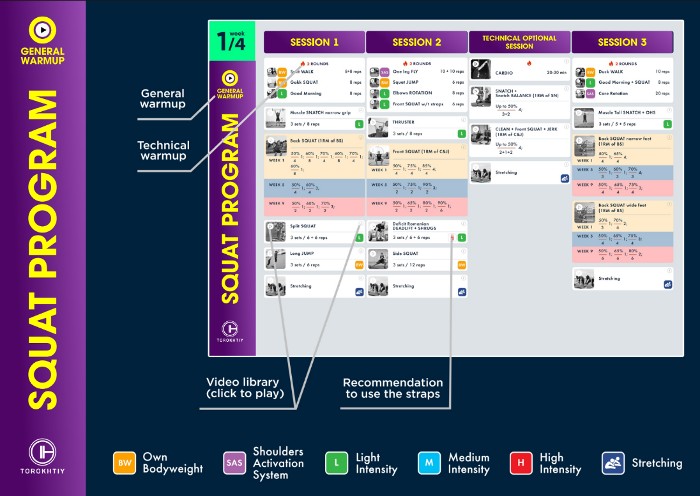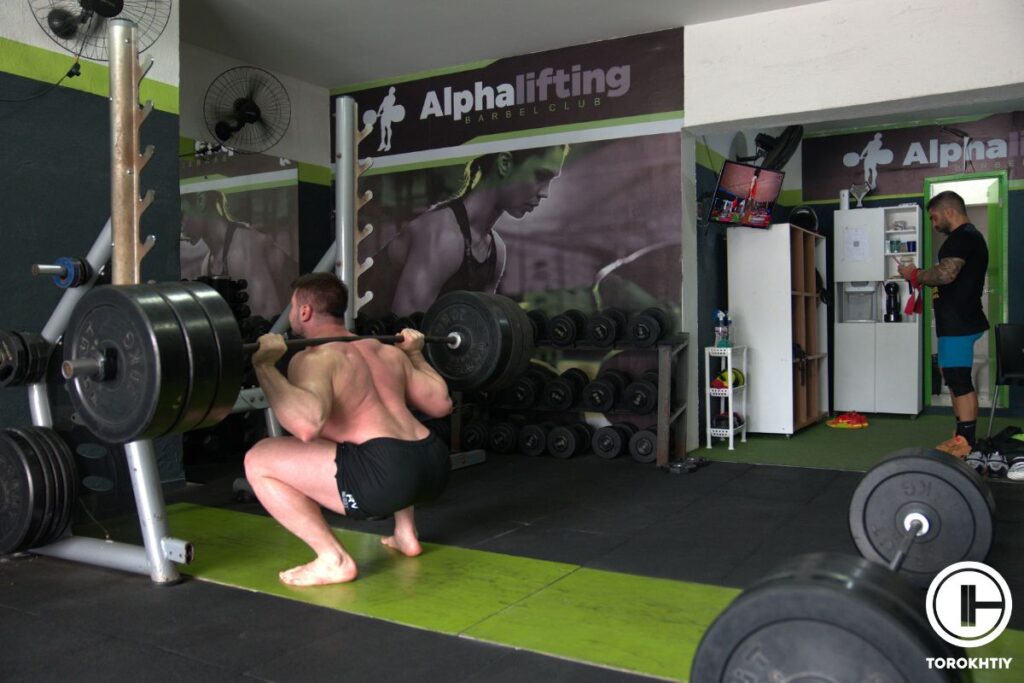Knees Over Toes When Squatting: Debunking Misconceptions
Author:
Reviewed by:
(21 years of Oly Lifting experience)
Unlock your full potential by engaging with our experts and community! Have questions about your fitness journey or looking for expert advice on weightlifting techniques? Don’t hesitate — leave a comment below and Sergii Putsov will provide a personalized answer and insights to help you reach your goals.
Torokhtiy is reader-supported. Some links are affiliate links, and we may earn a commission at no extra cost to you. See our disclosure page for details.
The squat is a foundational movement – cornerstone in strength & conditioning training and even every day normal life. Among the variations of this pivotal exercise is the controversial “knees over toes squatting”. This technique as the name implies involves bending the knees forward past the toes during the descent of squat.
For decades the prevailing wisdom in fitness circles has been to keep your knees behind your toes when squatting. This advice stemmed from a belief that the position would protect the knee joints from undue stress and potential injury. Some coaches and fitness enthusiasts have long echoed the mantra that allowing the knees to travel over the toes is a biomechanical misstep, one that could lead to strain ligaments and compromised stability.
However, the tides of opinion are changing with the currents of new research and experiential evidence. Now more fitness professionals are advocating for the inclusion of the knees over toes squatting, suggesting that, when done correctly it can be safe, but also beneficial. This shift is not without its critics, but it represents a growing willingness in the sport and fitness to challenge long-held beliefs and explore the full range of motion.
Knees over toes squatting, once discouraged, is now recognized for its benefits in enhancing lower body strength and mobility one executed with proper technique and individualized progression challenging outdated fitness dogmas.
The reevaluation of knees over toes squat is a testament to their evolving nature of exercise science. As we delve deeper into the beer mechanics of the human body, we uncover complexities that defy one-size-fits-all rules. The ones clear-cut guidelines are given way to more nuanced understanding that personal anatomy, mobility and strength play significant roles in what is safe and effective for each individual.
In this article we will explore the mechanics of squatting, dissect the debate surrounding thу dilemma “can knees go over toes when squatting” and present the argument for and against allowing the knees to move over the toes.

Understanding Squat Mechanics
The squad is a compound movement that engages multiple muscle groups and joints primarily targeting the hamstrings, quads, glutes and core. The anatomy of squads involves a synchronized act between muscle contractions and joint movements. When descending the hips move back and down well the knees and ankles flex and the torso lines slightly forward to keep and maintain balance.
The knee joint acts as a hinge with the quad and hamstring coordinating to lower and raise the body meanwhile the hip joint experiences flexion as the femur moves related to the pelvis. Proper engagement of the gluteal muscles is crucial for stabilizing the lower back and hips throughout the movement.
A common misconception is that deep squats or allowing the knees to pass over the toes are harmful. However, squat depth and new position are highly individual and can vary based on limp proportions mobility, flexibility and strength. While excessive forward new travel can increase stress on the knees it is not universally detrimental and can be a safe part of a well-designed athlete`s training.
Follow us!

Free!
Get a 2-week Weightlifting Program as a bonus for the subscription to kickstart your training plan!

Free!
The Knees Over Toes Debate
The debate surrounding the “squat knees over toes” position has its roots in the cautionary stance that has been pervasive since the late 20th century. For years the guideline was career clear and rarely questioned: when performing a squat, the knees should not pass beyond the toes. This belief was based on the premise that such movement increased the risk of knee injury, particularly to the anterior cruciate ligament (ACL).
Contrary to these traditional views recent researchers have eliminated a different narrative. Studies have shown that the knees over toes position does not necessarily lead to injury and can actually contribute to enhancing the stability and strength when incorporated in training with a proper progression and technique. Researchers advocate that restricting forward movement can lead to unusual stress on the lower back and limit the activation of the quads.

The benefits of training with their knees over toes squad can include improving lower back strength, increased knee and ankle flexibility and beds are functional movement patterns. Specifically, athletes that naturally involve a knees over toes position, like volleyball and basketball, may find this type of squat particularly useful.
However, it’s imperative to acknowledge the risks overload in the knee joint without adequate conditioning, mobility and technique can be problematic. It’s also important to consider individual differences in anatomy and biomechanics, which can make this technique less suitable for some.
Benefits Of Knees Over Toes Squatting
Knees over toes squatting has sparked interest due to its potential benefits, which extends beyond mere strength gains. Advocates argue that this method can lead to significant improvement in joint health, flexibility and overall athletic performance.
In terms of strength, allowing the knees to travel over the towels can result in greater range of motion, which engages the leg muscles more efficiently. This can lead to stronger, more powerful quads and glutes and also increased hamstring activation. The act of control in the squats throughout a larger range also encourages muscle control and endurance.
🔻GET A FREE PROGRAM DEMO: 12 Week Squat Program by Oleksiy Torokhtiy

Do you want to double your squat strength? In just 12 weeks, you’ll be able to boost your squat results.
Enter your details and get a free demo (1 free week) of the squat program straight into your inbox.
Flexibility benefits are also notable. This squat variation demands and develops greater ankle dorsiflexion – a movement where the toes move closer to the shin. Improved dorsiflexion can lead to better squat mechanics and reduce risk of injury. Additionally, the deep squat position helps maintain hip flexor suppleness, which is beneficial for lower back health.
Joint health may improve as well. Controlled knee-over-toe movement can strengthen the tendons and ligaments around the knee, potentially offering more stability and resilience. This can be particularly advantageous for individuals looking to improve their joint robustness in response to the demands of their training or regular activities.
Expert opinions support these potential benefits. Physical therapists have observed improved recovery and patients who engage in this type of squatting, while strength & conditioning coaches note its value in a comprehensive athletic training program. Scientific evidence, though still emerging, is beginning to support these observations, suggesting that when done correctly, knees over toes squatting can be safe and beneficial practice.

Risks and Considerations
While the knees over toes squat can be beneficial, it’s not without risks, especially if performed incorrectly or by people with pre-existing conditions. The primary risk is increased stress in squat knee position, which can lead to pain or injury in the patellar tendon or ligament if the individual lacks sufficient strength, mobility or technique.
Individuals with the history of new injuries or conditions like arthritis may need to approach this exercise with caution or avoid it. It’s crucial to consult with a qualified fitness professional before incorporating knees over toes squat squats into a workout regimen.
Technique and Progressions
To perform the squats safely, begin with bodyweight only and focus on form. Gradually increase depth as mobility improves, always ensuring that the heels remain flat on the ground.
1. Tips to Perform Knees Over Toes Squat Properly
- Stand feet shoulder-width apart.
- Begin by pushing the hips back while bending the knees out aligned with feet allowing them to track over toes.
- Keep the heels flat on the ground and chest up.
- Descent as low as possible without compromising for him ideally until the hamstrings cover the calves
- Push through the entire food to return to standing position.
2. Include Progression Exercises
- Ankle mobility drills to improve dorsiflexion range body weight.
- Squats to box to gradually lower the squat depth.
- Assisted squats using a rubber band or holding onto a stable object for balance.
3. Key Tips For Maintaining Form And Avoiding Injury
- Ensures knees remain aligned with the feet not caving in.
- Progress slowly, increasing depth and load overtime as strength and mobility improves.
- Listen to your body and back off if you experience pain beyond general muscle fatigue.
FAQ
Is It Ok For Knees To Go Over Toes When Squatting?
Yes, allowing knees to go over tells during squatting is acceptable for most people, provided it is done with proper form progression and without pre-existing knee conditions. This type of squats enhances strength and flexibility if integrated correctly into training.
Does Knees Over Toes Training Work?
Knees over toes training can be effective for improving lower body and total body strength, flexibility and joint resilience, especially when accompanied by correct technique and gradual progression based on individual fitness levels and mobility.
Conclusion
In conclusion knees over toes squatting challenges conventional wisdom offering potential benefits in strength flexibility and joint health when performed with proper technique and progression. However, it’s vital to approach this practice mindfully, considering individual biomechanics and potential risks to maximize its efficiency and safety. And now you give your opinion about this topic in the comment below!
Referenses:
- Illmeier G, Rechberger JS. The Limitations of Anterior Knee Displacement during Different Barbell Squat Techniques: A Comprehensive Review. J Clin Med. 2023 Apr 19;12(8):2955. doi: 10.3390/jcm12082955. PMID: 37109294; PMCID: PMC10143703.
- Wisløff U, Castagna C, Helgerud J, Jones R, Hoff J. Strong correlation of maximal squat strength with sprint performance and vertical jump height in elite soccer players. Br J Sports Med. 2004 Jun;38(3):285-8. doi: 10.1136/bjsm.2002.002071. PMID: 15155427; PMCID: PMC1724821.
- Ishida T, Samukawa M, Endo D, Kasahara S, Tohyama H. Effects of Changing Center of Pressure Position on Knee and Ankle Extensor Moments During Double-Leg Squatting. J Sports Sci Med. 2022 Sep 1;21(3):341-346. doi: 10.52082/jssm.2022.341. PMID: 36157389; PMCID: PMC9459773.
- Lorenzetti S, Ostermann M, Zeidler F, Zimmer P, Jentsch L, List R, Taylor WR, Schellenberg F. How to squat? Effects of various stance widths, foot placement angles and level of experience on knee, hip and trunk motion and loading. BMC Sports Sci Med Rehabil. 2018 Jul 17;10:14. doi: 10.1186/s13102-018-0103-7. Erratum in: BMC Sports Sci Med Rehabil. 2020 Jan 29;12:7. PMID: 30026952; PMCID: PMC6050697.
- Swinton PA, Lloyd R, Keogh JW, Agouris I, Stewart AD. A biomechanical comparison of the traditional squat, powerlifting squat, and box squat. J Strength Cond Res. 2012 Jul;26(7):1805-16. doi: 10.1519/JSC.0b013e3182577067. PMID: 22505136.
Why Trust Us?
With over 20 years in Olympic weightlifting, strength training, nutrition coaching, and general fitness our team does its best to provide the audience with ultimate support and meet the needs and requirements of advanced athletes and professional lifters, as well as people who strive to open new opportunities and develop their physical capabilities with us.
By trusting the recommendations of our certified experts in coaching, nutrition, and sports training programming, as well as scientific consultants, and physiotherapists, we provide you with thorough, well-considered, and scientifically proven content. All the information given in the articles concerning workout programming, separate exercises, and athletic performance, in general, is based on verified data.
The product testing process is described in more detail here.
Author: Sergii Putsov
Head of Sport Science, PhD
Best Results: Snatch – 165 kg,
C&J – 200 kg
Sergii Putsov, Ph.D., is a former professional weightlifter and National team member, achieving multiple medals in the 94 kg weight category at national competitions. With a Master’s degree in “Olympic & Professional Sport Training” and a Sport Science Ph.D. from the International Olympic Academy, Greece, Sergii now leads as the Head of Sport Science. He specializes in designing training programs, writing insightful blog articles, providing live commentary at international weightlifting events, and conducting educational seminars worldwide alongside Olympic weightlifting expert Oleksiy Torokhtiy.
Reviewed by: Oleksiy Torokhtiy
Olympic Weightlifting Champion, PhD in Sport Science
Best Results: Snatch – 200 kg,
C&J – 240 kg
Oleksiy Torokhtiy is a professional athlete boasting 20 years of experience in Olympic weightlifting. With multiple European and World titles under his belt, he has showcased his prowess in two Olympic Games (Beijing 2008 and London 2012). Upon concluding his illustrious career, Oleksiy dedicated himself to coaching. By 2022, he had conducted over 200 weightlifting seminars worldwide. He is the visionary behind an international sportswear and accessories brand known for its motto, “Warm Body Cold Mind.” Additionally, he is an esteemed author and the creator of a series of training programs and eBooks.




Still have questions after reading our article? Unlock your full potential by engaging with our experts and community! Don’t hesitate — leave a comment below and Sergii Putsov will provide a personalized answer and insights to help you reach your goals.